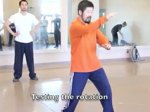Zoom lecture with Master Chen and Kelvin Ho covering six sealing four closing.
Morning session
- Use the dantian to connect to the elbow. Connect the rear leg to the arm through the kua, bypassing the upper body.
- When the move comes from the very inside, the thought is that it gets multiplied by 9.
Shoulder goes down
- Shoulder needs to go down to go through. It cannot go forward. To not get involved.
- Put a stick on the shoulder to show that it should not fight the stick, it should bypass it.
Habits
- It’s wrong because your body can’t sense it, you can only hear the words. To correct it will take 3 years. To correct ingrained habits.
Instructions
- Kua push up (such that head goes up)
- Shoulder push down (such that it slides down and does not follow the head)
- Hand goes out (such that it stays on the line)
- Hand cannot swing to the left / back.
- Hand rotates because the body rotates it. Hand cannot follow the waist.
Stretches
- Hand on the line, does not make moves on its own. Must maintain stretch through hand.
- Will make your body look bigger because of the stretches in the body.
Tearing
- Always keep in mind the purpose of the move.
- The two hands are placed and you want to stretch the forward hand forward and the rear hand backward.
- Like you’re holding a towel in both hands and tearing it apart.
- First using your arms, then shoulder, then kua.
Three primary exercises
- Pairs of three. Three primary exercises to practice tearing.
- 3 major directions.
- Twisting Towel: front
- Fetching Water: downwards and to the side
- Six Sealing Four Closing: leveled and 45° to the side
Automatic transmission
- Six sealing four closing is an automatic transmission: Switching gear all the time but so smooth you can’t feel it.
- The ratio between back and front changes as it changes from front kua to rear kua.
- Grab on (neutral) 50/50.
- Initiate: Then push hand a little (first gear) still 50/50.
- If opponent is strong, pivot closer to him. If weak, pivot far away.
- Switching must be a process that the opponent cannot feel.
- Question: if it relates to the 64 trigrams (no).
- But at a theoretical level (yes). The 64 trigrams relate to changes, at a theoretical level.
Afternoon session
Power in the stretch
- The power isn’t on the elbow or the shoulder, it’s in the air between your hand and the shoulder/back of your head/rear shoulder. Shoulder goes back, then back of head, then rear shoulder, then rear foot. Look for that power on the shoulder, it’s a very special feeling. Like you got it but you don’t got it. Feels like wind. Feel the pressure but don’t feel anything.
- The power of the arrow is not in the bow, or in the arrow. It’s through the string – It’s in the air of the stretch.
Go over / bypass
- Shoulder has to stretch backward.
- Bypasses the elbow. Go over. Power from shoulder has to shoot into the hand, bypassing the elbow.
- Creates a stretch from the hand to the shoulder.
- With a little bit of resistance, we have the tendency to let the power go back to our arms – have to train to empty it.
Exercise
- Lock underside of bicep, body, just move the forearm until it meet resistance.
- Change to only shoulder going back, bicep still locked.
- Start with your arm bent about 90° (so you have room to stretch). Move an inch to simulate 1.
- The shoulder and hand find that alignment.
- When doing it with resistance, you will not know when you are right, but the opponent will feel a gush of power. You have to experiment in push hands to find it.
- Get someone to stand to the side and behind you, grab the back of your shoulder and front of the hand and lock it. To give you resistance to find the stretch in your arm.
Anchor the elbow
- Opponent will only be able to find your hand and your shoulder (indirectly), not your elbow.
- They need 3 direct touches to move you. Anchor with the elbow. It does not go up. The angle changes.
Stretch the fingers
- Stretch through your fingers. Continuously. Imagine there is a point in front of the finger and stretch towards it, then another just in front of that.
Entice into emptiness
- A common problem in push hands when going back is that we twist/rotate instead of going back. Going back is totally linear. Creates a hole / entice into emptiness.
- When Master Chen adds rotation to it, that rotation must also create a hole.
Ratio
- Once you engage your opponent with your hand. The next move must still be on the shoulder-hand line.
- Shoulder ratio must be 2:1 to hand. Moving backwards must be larger than forward to produce power. Otherwise it attracts power (ratio favoring the hand).
- As a general rule, we never have enough backward move because that is human nature.
Backwards
- Leaning back is crucial to find the direction of the hand move. The upper arm (bicep) must not move at all. Must be bypassed Like how Master Chen arm wrestles by connecting the arm to the stomach muscles.
Scissors
- Two errors: the wrist bends; the head bends. They must lock so the forearm is a scissors blade and the torso to the head is a scissors blade.
[L (category)]”MiniEuropeanPrivate20210827″ Online Video Purchase



{ 1 comment… read it below or add one }
Thank you for the notes Edward Liaw. Excellent! Comprehensive and detailed.